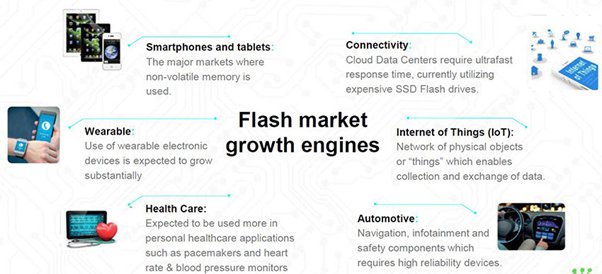RTO target Weebit announces major breakthrough in memory storage
Published 15-JAN-2016 12:44 P.M.
|
3 minute read
Hey! Looks like you have stumbled on the section of our website where we have archived articles from our old business model.
In 2019 the original founding team returned to run Next Investors, we changed our business model to only write about stocks we carefully research and are invested in for the long term.
The below articles were written under our previous business model. We have kept these articles online here for your reference.
Our new mission is to build a high performing ASX micro cap investment portfolio and share our research, analysis and investment strategy with our readers.
Click Here to View Latest Articles
Weebit-Nano Ltd, an RTO target for currently ASX-listed Radar Iron Ltd (ASX:RAD), has announced a significant technological breakthrough as part of its research and development work, developing the next generation of memory storage devices.
Weebit has managed to develop a “nano-porous Si ReRAM” solution with filament size less than 5 nanometres (nm) in scale.
The ability to scale down to this level of nano-miniaturisation has been one of the major challenges facing filament-based ReRAM technology development. Currently, the cut-off point whereby further minituarisation was thought to be impossible was 16nm.
Weebit has potentially opened the flash memory gates to go into a paradigm shift and enter a new level of efficiency.
Prior to this breakthrough development has been restricted at the 16nm and 10nm levels due to restrictions imposed by the laws of physics.
“As filament size decreases, electrical current densities increase; the same amount of electricity needs to travel through a smaller surface area of filament. This can lead to filament ‘burn-out’, or in less severe cases compromising performance reliability” according to today’s Weebit announcement.
Developers of other filamentary ReRAM technologies that are based on metal oxides are unlikely to be able to scale down below 16nm to compete with Weebit, without significantly impairing their performance and reliability.
Weebit’s breakthrough could potentially create a patent-protected competitive advantage that enables the re-listed entity to become a dominant force in ReRAM memory storage in the coming years.
RAD’s takeover of Weebit is expected to complete later this year following the completion of a due diligence period in earlier this month.
Once the RTO deal is formalised, RAD will acquire 100% of Israel-based Weebit-Nano, and move into the ‘non-volatile memory market’ expected to grow from US$580 million in 2015 to US$3.6 billion in 2020 – a growth rate of 520% over five years. Tech analysts expect ReRAM technology to become the market leader in memory storage given its capacity to store more information with better reliability and with smaller components that allow for miniature products to be built. ReRAM technology can replace traditional Flash memory, and is expected to be used widely from 2018 onwards.

A forecasted 40 zettabytes of storable content will be produced annually by 2020, and that number is expected to continue doubling every 2 years. One zettabyte is equal to a thousand exabytes or a billion terabytes.
Looking ahead
Having developed a superior storage solution to the rest of the market, Weebit hopes to have a prototype product built within the next 18 months and says it’s already “advancing discussions with four global recognised Research and Development companies”.
In addition, Weebit is conducting negotiations with prominent semiconductor manufacturers regarding joint venture development, with today’s news “expected to hasten those discussions”.
About Weebit Nano
Weebit was incorporated in Israel in 2014. Domiciled in Tel Aviv, Weebit in partnership with Rice University is one of the world’s foremost developers of Silicon Oxide {SiOx) ReRAM technology. It has been built around a revolutionary memory and semiconductor technology invented by Professor James Tour of Rice University in Houston, Texas.
Weebit is developing Tour’s new silicon oxide (SiOx) Resistive Random Access Memory (ReRAM) technology, and will be able to show a commercially viable product within 18 months. This quantum leap will allow semiconductor memory elements to become cheaper, faster, more reliable and more energy efficient than the existing Flash technology.
Weebit’s technology has also been field tested by NASA. The US space agency sent Weebit’s components on a two year space mission where intensive testing led to NASA awarding Weebit’s components with ‘Hard-Rad’ status, meaning they are “impervious to the effects of radiation”.
General Information Only
This material has been prepared by StocksDigital. StocksDigital is an authorised representative (CAR 000433913) of 62 Consulting Pty Limited (ABN 88 664 809 303) (AFSL 548573).
This material is general advice only and is not an offer for the purchase or sale of any financial product or service. The material is not intended to provide you with personal financial or tax advice and does not take into account your personal objectives, financial situation or needs. Although we believe that the material is correct, no warranty of accuracy, reliability or completeness is given, except for liability under statute which cannot be excluded. Please note that past performance may not be indicative of future performance and that no guarantee of performance, the return of capital or a particular rate of return is given by 62C, StocksDigital, any of their related body corporates or any other person. To the maximum extent possible, 62C, StocksDigital, their related body corporates or any other person do not accept any liability for any statement in this material.
Conflicts of Interest Notice
S3 and its associated entities may hold investments in companies featured in its articles, including through being paid in the securities of the companies we provide commentary on. We disclose the securities held in relation to a particular company that we provide commentary on. Refer to our Disclosure Policy for information on our self-imposed trading blackouts, hold conditions and de-risking (sell conditions) which seek to mitigate against any potential conflicts of interest.
Publication Notice and Disclaimer
The information contained in this article is current as at the publication date. At the time of publishing, the information contained in this article is based on sources which are available in the public domain that we consider to be reliable, and our own analysis of those sources. The views of the author may not reflect the views of the AFSL holder. Any decision by you to purchase securities in the companies featured in this article should be done so after you have sought your own independent professional advice regarding this information and made your own inquiries as to the validity of any information in this article.
Any forward-looking statements contained in this article are not guarantees or predictions of future performance, and involve known and unknown risks, uncertainties and other factors, many of which are beyond our control, and which may cause actual results or performance of companies featured to differ materially from those expressed in the statements contained in this article. S3 cannot and does not give any assurance that the results or performance expressed or implied by any forward-looking statements contained in this article will actually occur and readers are cautioned not to put undue reliance on forward-looking statements.
This article may include references to our past investing performance. Past performance is not a reliable indicator of our future investing performance.

